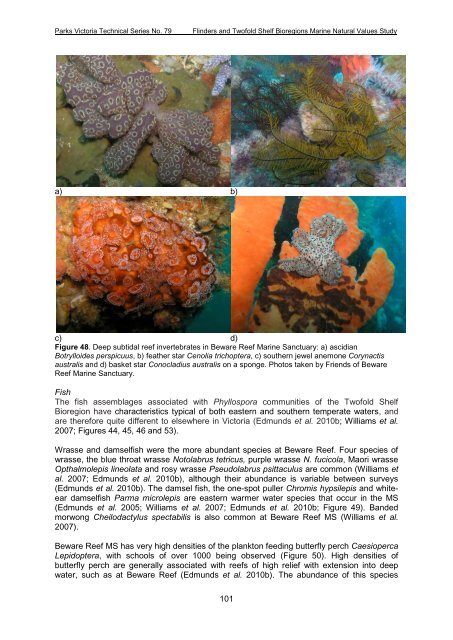parks victoria technical series marine natural values study vol 2 ...
parks victoria technical series marine natural values study vol 2 ...
parks victoria technical series marine natural values study vol 2 ...
Create successful ePaper yourself
Turn your PDF publications into a flip-book with our unique Google optimized e-Paper software.
Parks Victoria Technical Series No. 79<br />
Flinders and Twofold Shelf Bioregions Marine Natural Values Study<br />
a) b)<br />
c) d)<br />
Figure 48. Deep subtidal reef invertebrates in Beware Reef Marine Sanctuary: a) ascidian<br />
Botrylloides perspicuus, b) feather star Cenolia trichoptera, c) southern jewel anemone Corynactis<br />
australis and d) basket star Conocladius australis on a sponge. Photos taken by Friends of Beware<br />
Reef Marine Sanctuary.<br />
Fish<br />
The fish assemblages associated with Phyllospora communities of the Twofold Shelf<br />
Bioregion have characteristics typical of both eastern and southern temperate waters, and<br />
are therefore quite different to elsewhere in Victoria (Edmunds et al. 2010b; Williams et al.<br />
2007; Figures 44, 45, 46 and 53).<br />
Wrasse and damselfish were the more abundant species at Beware Reef. Four species of<br />
wrasse, the blue throat wrasse Notolabrus tetricus, purple wrasse N. fucicola, Maori wrasse<br />
Opthalmolepis lineolata and rosy wrasse Pseudolabrus psittaculus are common (Williams et<br />
al. 2007; Edmunds et al. 2010b), although their abundance is variable between surveys<br />
(Edmunds et al. 2010b). The damsel fish, the one-spot puller Chromis hypsilepis and whiteear<br />
damselfish Parma microlepis are eastern warmer water species that occur in the MS<br />
(Edmunds et al. 2005; Williams et al. 2007; Edmunds et al. 2010b; Figure 49). Banded<br />
morwong Cheilodactylus spectabilis is also common at Beware Reef MS (Williams et al.<br />
2007).<br />
Beware Reef MS has very high densities of the plankton feeding butterfly perch Caesioperca<br />
Lepidoptera, with schools of over 1000 being observed (Figure 50). High densities of<br />
butterfly perch are generally associated with reefs of high relief with extension into deep<br />
water, such as at Beware Reef (Edmunds et al. 2010b). The abundance of this species<br />
101

















